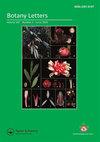新喀里多尼亚超基性基质上的森林和树种分布
IF 1.3
4区 生物学
Q3 PLANT SCIENCES
引用次数: 2
摘要
新喀里多尼亚约有三分之一的土地覆盖着超基性土壤(UM),这里拥有丰富的植物群(特有率为85%),这些植物群受到采矿活动的威胁。这种组合使超镁铁质植被成为生物多样性热点中的植物区系热点。UM土壤分布在海平面至海拔1618米之间,其中约三分之二形成一个大的连续单元,而其余的形成许多相对较小的孤立单元。在这里,我们提供了22个UM单位的森林和树种分布的综合。我们编制了一个广泛的树木发生数据集(109,896个事件和1,065个物种)和一个新的基于专家的森林地图,空间分辨率为1:3000。这些物种中只有10%的物种代表了50%以上的发生率,而10%的物种只出现过一到两次。四分之一的保护区没有发现任何物种,我们估计在22个保护区中,平均还有四分之一的物种有待查获。森林覆盖了大约三分之一的UM地区,不同UM单位的森林覆盖率从1.7%到72.3%不等。森林覆盖率从海平面的14.6%增加到海拔1200米的93.3%。约30%的森林和90%的物种位于采矿特许权范围内,14.5%和73%分别位于保护区内。我们建议在超基性基底上建立新的保护区,特别是在北方省,以保护更多的森林和它所拥有的多样性。本文章由计算机程序翻译,如有差异,请以英文原文为准。
Forest and tree species distribution on the ultramafic substrates of New Caledonia
ABSTRACT About a third of New Caledonia is covered with ultramafic soils (UM) which hosts a rich flora (endemism > 85%) threatened by mining activities. This combination makes the ultramafic vegetation a floristic hotspot within a biodiversity hotspot. UM soils are distributed from sea level to 1618 m elevation with about two-thirds forming a large continuous unit while the remaining forms numerous relatively small isolated units. Here, we provide a synthesis of the distribution of forest and tree species across 22 UM units. We compiled an extensive tree occurrence dataset (109,896 occurrences and 1,065 species) and a new expert-based forest map at a 1:3000 spatial resolution. Only 10% of these species represented more than 50% of the occurrences, while 10% of the species had only one or two occurrences. A quarter of the UM area did not contain any occurrences, and we estimated that on average a quarter of the species remained to be inventoried in the 22 units. Forest covers about one-third of the UM areas with forest coverage ranging from 1.7% to 72.3% in the different UM units. Forest coverage increased from 14.6% on sea level to 93.3% at 1,200 m of elevation. About 30% of the forest and 90% of the species were located within mining concessions, while 14.5% and 73%, respectively, were located within protected areas. We recommend setting up new protected areas on ultramafic substrate, specially in the Northern province, to protect more forest and the diversity it harbours.
求助全文
通过发布文献求助,成功后即可免费获取论文全文。
去求助
来源期刊

Botany Letters
Agricultural and Biological Sciences-Plant Science
CiteScore
3.10
自引率
6.70%
发文量
54
期刊介绍:
Botany Letters is an international scientific journal, published by the French Botanical Society (Société botanique de France) in partnership with Taylor & Francis. Botany Letters replaces Acta Botanica Gallica, which was created in 1993, building on over a century of renowned publications by the Société botanique de France.
 求助内容:
求助内容: 应助结果提醒方式:
应助结果提醒方式:


